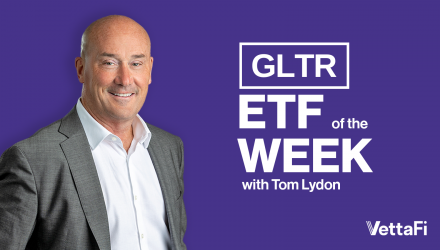VettaFi’s vice chairman Tom Lydon discussed the abrdn Physical Precious Metals Basket Shares ETF (GLTR) on this week’s “ETF of the Week” podcast with Chuck Jaffe of “Money Life.”
GLTR is shining to Lydon right now as recent U.S. economic data releases show signs of sticky inflation, with inflation numbers climbing unexpectedly higher in January.
Lydon said that with the Fed hiking interest rates, a lot of people were hoping to see inflation numbers come down meaningfully. While inflation came down a bit before increasing modestly in January, it’s time to start discussing the potential for sticky inflation, according to Lydon.
“One thing that a lot of folks haven’t talked about is ‘could we live with higher average inflation for an extended period of time?’” Lydon said. “And the answer is yes, there are a lot of times in history where inflation might have run from four to six percent for a two- or three-year period of time, and actually, the market did quite well.”
“The fact that gold and general precious metals are well off their highs, and with the idea that we’re going to continue to see inflation and may see inflationary numbers for a few years, it may be a good case to own a basket of metals, not just gold,” Lydon added.
GLTR comprises about 60% gold and 26% silver, but the remaining allocation is in platinum and palladium, offering diversified exposure to precious metals.
“You and I’ve talked about this before, Chuck: All precious metals do not operate and perform the same way over time,” Lydon said. “It’s a way to give you kind of a diversified allocation into precious metals at a time that we may continue to see inflationary numbers be greater than expected for the coming couple of years.”
Considering the underlying uses of each precious metals helps to explain the difference in performance. While gold is still primarily used in jewelry, silver also sees industrial demand. Platinum and palladium see primarily industrial demand, an essential component in the catalytic converters used in cars, among other things.
“The average car on the road is the oldest it’s ever been, averaging around 10 years, and eventually, if the economy comes in for a soft landing, we continue to see growth, there are going to be areas like the automotive industry where people are going to have to eventually get new cars,” Lydon said.
In terms of how much of a portfolio to allocate to precious metals, while 10 years ago, a 5% to 10% allocation to gold made sense, with the proliferation of ETFs and offerings beyond gold today, 10% is now an ideal number, Lydon added.
In addition to being a core allocation in portfolios, diversified precious metals are also a trend following opportunity. For investors using precious metals from a trend following standpoint, Lydon said allocating an additional 10% might be something to consider.
Listen to the Whole Episode Covering GLTR Here:
For more news, information, and analysis, visit the Commodities Channel.

